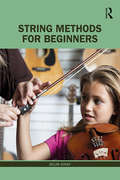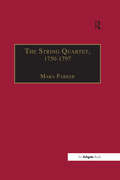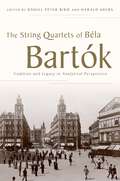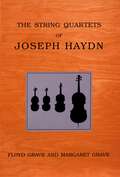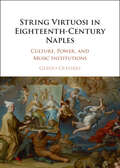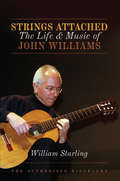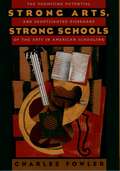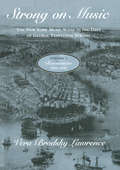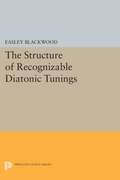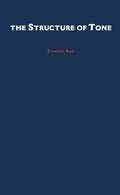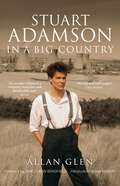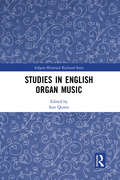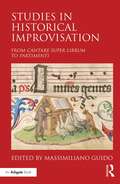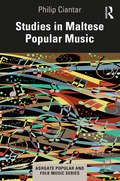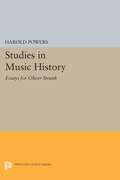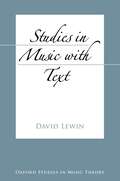- Table View
- List View
String Methods for Beginners
by Selim GirayString Methods for Beginners is designed for students to receive the essential playing and teaching skills on all orchestral string instruments. The goal of this textbook is to be truly methodical in its approach, and to assist the instructor, completely eliminating the need to do additional research, or reorganization in preparation to teach this class. Students will gain the basic knowledge and experience to teach bowed stringed instruments in public schools. String Methods for Beginners covers the necessary topics to learn and teach the violin, viola, cello, and string bass. It explores the fundamentals of those instruments and teaching considerations, utilizing a heterogeneous approach. As the primary resource to any college- and university-level String Techniques, String Methods, or Instrumental Methods class, this course book fits into a standard semester, comprised of 25 lessons, which correspond with two hourly classes per week for the term. It provides the instructor with the tools to teach a classroom of non-majors or string education majors, or a mixed classroom of both. FEATURES Offers a blueprint for a semester long string methods course. For beginning students, and also comprehensive for more in-depth study or for reference. Logical, step-by-step "recipe-like" approach.
The String Quartet, 1750–1797: Four Types of Musical Conversation
by Mara ParkerThe second half of the eighteenth century witnessed a flourishing of the string quartet, often represented as a smooth and logical progression from first violin-dominated homophony to a more equal conversation between the four voices. Yet this progression was neither as smooth nor as linear as previously thought, as Mara Parker illustrates in her examination of the string quartet during this period. Looking at a wide variety of string quartets by composers such as Pleyel, Distler and Filtz, in addition to Haydn and Mozart, the book proposes a new way of describing the relationships between the four instruments in different works. Broadly speaking, these relationships follow one of four patterns: the 'lecture', the 'polite conversation', the 'debate', and the 'conversation'. In focusing on these musical discourses, it becomes apparent that each work is the product of its composer's stylistic choices, location, intended performers and intended audience. Instead of evolving in a strict and universal sequence, the string quartet in the latter half of the eighteenth century was a complex genre with composers mixing and matching musical discourses as circumstances and their own creative impulses required.
The String Quartet, 1750–1797: Four Types of Musical Conversation
by Mara ParkerThe second half of the eighteenth century witnessed a flourishing of the string quartet, often represented as a smooth and logical progression from first violin-dominated homophony to a more equal conversation between the four voices. Yet this progression was neither as smooth nor as linear as previously thought, as Mara Parker illustrates in her examination of the string quartet during this period. Looking at a wide variety of string quartets by composers such as Pleyel, Distler and Filtz, in addition to Haydn and Mozart, the book proposes a new way of describing the relationships between the four instruments in different works. Broadly speaking, these relationships follow one of four patterns: the 'lecture', the 'polite conversation', the 'debate', and the 'conversation'. In focusing on these musical discourses, it becomes apparent that each work is the product of its composer's stylistic choices, location, intended performers and intended audience. Instead of evolving in a strict and universal sequence, the string quartet in the latter half of the eighteenth century was a complex genre with composers mixing and matching musical discourses as circumstances and their own creative impulses required.
The String Quartets of Béla Bartók: Tradition and Legacy in Analytical Perspective
Béla Bartók (1881-1945) was one of the most important composers and musical thinkers of the 20th century. His contributions as a composer, as a performer and as the father of ethnomusicology changed the course of music history and of our contemporary perception of music itself. At the center of Bartók's oeuvre are his string quartets, which are generally acknowledged as some of the most significant pieces of 20th century chamber music. The String Quartets of Béla Bartók brings together innovative new scholarship from 14 internationally recognized music theorists, musicologists, performers, and composers to focus on these remarkable works from a range of theoretical and methodological perspectives. Focusing on a variety of aspects of the string quartets-harmony and tonality, form, rhythm and meter, performance and listening-it considers both the imprint of folk and classical traditions on Bartók's string quartets, and the ways in which they influenced works of the next generation of Hungarian composers. Rich with notated music examples the volume is complemented by an Oxford Web Music companion website offering additional notated as well as recorded examples. The String Quartets of Béla Bartók, reflecting the impact of the composer himself, is an essential resource for scholars and students across a variety of fields from music theory and musicology, to performance practice and ethnomusicology.
The String Quartets of Joseph Haydn
by Floyd Grave Margaret GraveRenowned music historians Floyd and Margaret Grave present a fresh perspective on a comprehensive survey of the works. This thorough and unique analysis offers new insights into the creation of the quartets, the wealth of musical customs and conventions on which they draw, the scope of their innovations, and their significance as reflections of Haydn's artistic personality. Each set of quartets is characterized in terms of its particular mix of structural conventions and novelties, stylistic allusions, and its special points of connection with other opus groups in the series. Throughout the book, the authors draw attention to the boundless supply of compositional strategies by which Haydn appears to be continually rethinking, reevaluating, and refining the quartet's potentials. They also lucidly describe Haydn's famous penchant for wit, humor, and compositional artifice, illuminating the unexpected connections he draws between seemingly unrelated ideas, his irony, and his lightning bolts of surprise and thwarted expectation. Approaching the quartets from a variety of vantage points, the authors correct many prevailing assumptions about convention, innovation, and developing compositional technique in the music of Haydn and his contemporaries.
The String Quartets of Joseph Haydn
by Floyd Grave Margaret GraveRenowned music historians Floyd and Margaret Grave present a fresh perspective on a comprehensive survey of the works. This thorough and unique analysis offers new insights into the creation of the quartets, the wealth of musical customs and conventions on which they draw, the scope of their innovations, and their significance as reflections of Haydn's artistic personality. Each set of quartets is characterized in terms of its particular mix of structural conventions and novelties, stylistic allusions, and its special points of connection with other opus groups in the series. Throughout the book, the authors draw attention to the boundless supply of compositional strategies by which Haydn appears to be continually rethinking, reevaluating, and refining the quartet's potentials. They also lucidly describe Haydn's famous penchant for wit, humor, and compositional artifice, illuminating the unexpected connections he draws between seemingly unrelated ideas, his irony, and his lightning bolts of surprise and thwarted expectation. Approaching the quartets from a variety of vantage points, the authors correct many prevailing assumptions about convention, innovation, and developing compositional technique in the music of Haydn and his contemporaries.
String Virtuosi in Eighteenth-Century Naples: Culture, Power, And Music Institutions
by Guido OlivieriStrings Attached: The Life and Music of John Williams
by William StarlingStrings Attached is the much anticipated authorised biography of John Williams, one of the most accomplished and celebrated musicians of his generation. From his childhood in Australia to his stellar career in London and around the world, John Williams has lived an extraordinary life. Master of the classical repertoire, he took the guitar to a wider audience with the band SKY and by his championing of the music of South America and Africa. William Starling came to know John Williams through their mutual friend, jazz guitarist John Etheridge. As their friendship developed, he put it to the maestro that it was time for a biography. To his lasting amazement, the famously private Williams agreed. Strings Attached is the product of extensive research and uniquely privileged access to John Williams, his family, friends and musical associates. It is the first telling of the fascinating life and career of a world-renowned musician and, equally, the story of a man and the making of his identity.
Strong Arts, Strong Schools: The Promising Potential and Shortsighted Disregard of the Arts in American Schooling
by the late Charles FowlerIn this elegantly written, passionately argued book, Fowler presents a convincing case for teaching the arts to all children. He argues that, far from a luxury, the arts are a vitally important part of our society and our schools. Highlighting the crucial effect of the arts on learning, this volume shows how the arts can enliven and extend the entire school curriculum by integrating different subjects in innovative interdisciplinary ways. These eighteen compelling essays are a clarion call to action for any teacher, parent, policy maker, or citizen concerned about the fate of the arts in American society and schools.
Strong Arts, Strong Schools: The Promising Potential and Shortsighted Disregard of the Arts in American Schooling
by the late Charles FowlerIn this elegantly written, passionately argued book, Fowler presents a convincing case for teaching the arts to all children. He argues that, far from a luxury, the arts are a vitally important part of our society and our schools. Highlighting the crucial effect of the arts on learning, this volume shows how the arts can enliven and extend the entire school curriculum by integrating different subjects in innovative interdisciplinary ways. These eighteen compelling essays are a clarion call to action for any teacher, parent, policy maker, or citizen concerned about the fate of the arts in American society and schools.
Strong on Music: The New York Music Scene in the Days of George Templeton Strong, Volume 1: Resonances, 1836-1849
by Vera Brodsky LawrenceIn Strong on Music Vera Brodsky Lawrence uses the diaries of lawyer and music lover George Templeton Strong as a jumping-off point from which to explore every aspect of New York City's musical life in the mid-nineteenth century. Formerly a concert pianist, Vera Brodsky Lawrence spent the last third of her life as a historian of American music (she died in 1996). She was editor of The Piano Works of Louis Moreau Gottschalk and The Complete Works of Scott Joplin. On Volume 1: "A marvelous book. There is nothing like it in the literature of American music."—Harold C. Schonberg, New York Times Book Review On Volume 2: "A monumental achievement."—Victor Fell Yellin, Opera Quarterly
The Structure of Recognizable Diatonic Tunings
by Easley BlackwoodIn a comprehensive work with important implications for tuning theory and musicology, Easley Blackwood, a distinguished-composer, establishes a mathematical basis for the family of diatonic tunings generated by combinations of perfect fifths and octaves.Originally published in 1986.The Princeton Legacy Library uses the latest print-on-demand technology to again make available previously out-of-print books from the distinguished backlist of Princeton University Press. These editions preserve the original texts of these important books while presenting them in durable paperback and hardcover editions. The goal of the Princeton Legacy Library is to vastly increase access to the rich scholarly heritage found in the thousands of books published by Princeton University Press since its founding in 1905.
The Structure Of Tone
by Zhiming BaoThis book argues a fresh theory about the structure of tone. Bao investigates a wide range of tone sandhi data from various Chinese dialects and other Asian tone languages, providing empirical support for his proposal that tone is a formal entity which consists of register and contour. Bao establishes a clear typological distinction between register tone languages and contour tone languages whose contour tones have a more complex structure.
Stuart Adamson: In a Big Country
by Allan GlenThis is the book that fans of the Skids, Big Country and the Raphaels have been waiting for - a critical perspective not only of Adamson's music and its wider cultural influence, but also the excesses of fame and how the music business really works. Stuart Adamson: In a Big Country tells the story of how a teenager who was raised in a small Fife village released his first single at 19, wrote three Top 40 albums in the next three years and was written off as a has-been at 23, but then went on to form a new band and sell more than 10 million records worldwide, touring with the Rolling Stones and David Bowie. Although Stuart Adamson was one of the most respected and popular figures in the music industry, his personal life was complex - depression, alcoholism and estrangement - and ultimately tragic, ending with his suicide in a Hawaiian hotel in December 2001.
Studies in English Organ Music (Ashgate Historical Keyboard Series)
by Iain QuinnStudies in English Organ Music is a collection of essays by expert authors that examines key areas of the repertoire in the history of organ music in England. The essays on repertoire are placed alongside supporting studies in organ building and liturgical practice in order to provide a comprehensive contextualization. An analysis of the symbiotic relationship between the organ, liturgy, and composers reveals how the repertoire has been shaped by these complementary areas and developed through history. This volume is the first collection of specialist studies related to the field of English organ music.
Studies in English Organ Music (Ashgate Historical Keyboard Series)
by Iain QuinnStudies in English Organ Music is a collection of essays by expert authors that examines key areas of the repertoire in the history of organ music in England. The essays on repertoire are placed alongside supporting studies in organ building and liturgical practice in order to provide a comprehensive contextualization. An analysis of the symbiotic relationship between the organ, liturgy, and composers reveals how the repertoire has been shaped by these complementary areas and developed through history. This volume is the first collection of specialist studies related to the field of English organ music.
Studies in Historical Improvisation: From Cantare super Librum to Partimenti
by Massimiliano GuidoIn recent years, scholars and musicians have become increasingly interested in the revival of musical improvisation as it was known in the Renaissance and Baroque periods. This historically informed practice is now supplanting the late Romantic view of improvised music as a rhapsodic endeavour—a musical blossoming out of the capricious genius of the player—that dominated throughout the twentieth century. In the Renaissance and Baroque eras, composing in the mind (alla mente) had an important didactic function. For several categories of musicians, the teaching of counterpoint happened almost entirely through practice on their own instruments. This volume offers the first systematic exploration of the close relationship among improvisation, music theory, and practical musicianship from late Renaissance into the Baroque era. It is not a historical survey per se, but rather aims to re-establish the importance of such a combination as a pedagogical tool for a better understanding of the musical idioms of these periods. The authors are concerned with the transferral of historical practices to the modern classroom, discussing new ways of revitalising the study and appreciation of early music. The relevance and utility of such an improvisation-based approach also changes our understanding of the balance between theoretical and practical sources in the primary literature, as well as the concept of music theory itself. Alongside a word-centred theoretical tradition, in which rules are described in verbiage and enriched by musical examples, we are rediscovering the importance of a music-centred tradition, especially in Spain and Italy, where the music stands alone and the learner must distil the rules by learning and playing the music. Throughout its various sections, the volume explores the path of improvisation from theory to practice and back again.
Studies in Historical Improvisation: From Cantare super Librum to Partimenti
by Massimiliano GuidoIn recent years, scholars and musicians have become increasingly interested in the revival of musical improvisation as it was known in the Renaissance and Baroque periods. This historically informed practice is now supplanting the late Romantic view of improvised music as a rhapsodic endeavour—a musical blossoming out of the capricious genius of the player—that dominated throughout the twentieth century. In the Renaissance and Baroque eras, composing in the mind (alla mente) had an important didactic function. For several categories of musicians, the teaching of counterpoint happened almost entirely through practice on their own instruments. This volume offers the first systematic exploration of the close relationship among improvisation, music theory, and practical musicianship from late Renaissance into the Baroque era. It is not a historical survey per se, but rather aims to re-establish the importance of such a combination as a pedagogical tool for a better understanding of the musical idioms of these periods. The authors are concerned with the transferral of historical practices to the modern classroom, discussing new ways of revitalising the study and appreciation of early music. The relevance and utility of such an improvisation-based approach also changes our understanding of the balance between theoretical and practical sources in the primary literature, as well as the concept of music theory itself. Alongside a word-centred theoretical tradition, in which rules are described in verbiage and enriched by musical examples, we are rediscovering the importance of a music-centred tradition, especially in Spain and Italy, where the music stands alone and the learner must distil the rules by learning and playing the music. Throughout its various sections, the volume explores the path of improvisation from theory to practice and back again.
Studies in Maltese Popular Music (Ashgate Popular and Folk Music Series)
by Philip CiantarThis book examines the diverse facets of popular music in Malta, paying special attention to għana (Malta’s folk song), the wind band tradition, and modern popular music. Ciantar provides intriguing discussions and examples of how popular music on this small Mediterranean island country interacts with other aspects of the island’s life and culture such as language, religion, history, customs, and politics. Through a series of ethnographic vignettes, the book explores the music as it takes place in bars, at festivals, and during village celebrations, and considers how it is talked about in the local press, at group gatherings, and on social media. The ethnography adopted here is that of a native musician and ethnomusicologist and therefore marries the author’s memories with ongoing observations and their evaluation.
Studies in Maltese Popular Music (Ashgate Popular and Folk Music Series)
by Philip CiantarThis book examines the diverse facets of popular music in Malta, paying special attention to għana (Malta’s folk song), the wind band tradition, and modern popular music. Ciantar provides intriguing discussions and examples of how popular music on this small Mediterranean island country interacts with other aspects of the island’s life and culture such as language, religion, history, customs, and politics. Through a series of ethnographic vignettes, the book explores the music as it takes place in bars, at festivals, and during village celebrations, and considers how it is talked about in the local press, at group gatherings, and on social media. The ethnography adopted here is that of a native musician and ethnomusicologist and therefore marries the author’s memories with ongoing observations and their evaluation.
Studies in Music History: Essays for Oliver Strunk
by Harold PowersA wide variety of essays by colleagues and former students reflect Professor Strunk's particular role as music historian, teacher, and a pre-eminent musicologist. Donald Grout provides the introduction and outlines the problems confronting musicology today. Other essays are devoted to early Christian music, Renaissance music, early Italian opera; Arthur Mendel writes on ambiguities of the munsural system, Edward Lowinsky on Willaert’s "Chromatic Duo," Joseph Kerman on Verdi, and Elliot Forbes on Beethoven.Originally published in 1958.The Princeton Legacy Library uses the latest print-on-demand technology to again make available previously out-of-print books from the distinguished backlist of Princeton University Press. These editions preserve the original texts of these important books while presenting them in durable paperback and hardcover editions. The goal of the Princeton Legacy Library is to vastly increase access to the rich scholarly heritage found in the thousands of books published by Princeton University Press since its founding in 1905.
Studies in Music with Text (Oxford Studies in Music Theory)
by David LewinThroughout his career, David Lewin labored to make even the most abstract theory speak to the experience of the ordinary listener. This book combines many of Lewin's classic articles on song and opera with newly drafted chapters on songs of Brahms, Robert Schumann, Clara Schumann, and Milton Babbitt. Bound together by Lewin's cogent insight, the resulting collection constitutes a major statement concerning the methodological problems associated with interpretation of texted music.
Studies in Music with Text (Oxford Studies in Music Theory)
by David LewinThroughout his career, David Lewin labored to make even the most abstract theory speak to the experience of the ordinary listener. This book combines many of Lewin's classic articles on song and opera with newly drafted chapters on songs of Brahms, Robert Schumann, Clara Schumann, and Milton Babbitt. Bound together by Lewin's cogent insight, the resulting collection constitutes a major statement concerning the methodological problems associated with interpretation of texted music.
Studies in Music, Words, and Imagery in Early Modern Europe (Variorum Collected Studies)
by Barbara Russano HanningCharacterized by an interdisciplinary approach, these essays highlight the relationship between music and poetry in Italian secular works of the late sixteenth and early seventeenth centuries, examine the role of images in shedding light on the cultural context in which these and other works came into being (music iconography), and explore the binaries and similarities of the arts in this period. Insights about early opera are complemented by discussions of accompanied solo song, or monody, both genres new to Italian music at the turn of the seventeenth century.Many chapters focus on specific images, ranging from the figure of Apollo and his significance as the earliest operatic protagonist, to an early eighteenth-century representation of a salon concert and its “ensemblisation” of events that likely occurred serially. Others include discussions and analyses of musical poetics, from Tasso’s influence on the Italian madrigal to Rinuccini’s authorship of the earliest opera libretti. Another focuses on history while narrating the circumstances under which opera came into being in late Renaissance Florence.Addressed in large measure to teachers and students, Studies in Music, Words, and Imagery in Early Modern Europe presents a range of subjects that broaden our perspective on the era. Certain essays take a specifically pedagogical approach, while others are more apt to interest music historians or those familiar with Italian versification. All are presented with a view toward making more accessible essays that do not fit neatly into one subject area but cross boundary lines between music, words, and images.
Studies in Music, Words, and Imagery in Early Modern Europe (Variorum Collected Studies)
by Barbara Russano HanningCharacterized by an interdisciplinary approach, these essays highlight the relationship between music and poetry in Italian secular works of the late sixteenth and early seventeenth centuries, examine the role of images in shedding light on the cultural context in which these and other works came into being (music iconography), and explore the binaries and similarities of the arts in this period. Insights about early opera are complemented by discussions of accompanied solo song, or monody, both genres new to Italian music at the turn of the seventeenth century.Many chapters focus on specific images, ranging from the figure of Apollo and his significance as the earliest operatic protagonist, to an early eighteenth-century representation of a salon concert and its “ensemblisation” of events that likely occurred serially. Others include discussions and analyses of musical poetics, from Tasso’s influence on the Italian madrigal to Rinuccini’s authorship of the earliest opera libretti. Another focuses on history while narrating the circumstances under which opera came into being in late Renaissance Florence.Addressed in large measure to teachers and students, Studies in Music, Words, and Imagery in Early Modern Europe presents a range of subjects that broaden our perspective on the era. Certain essays take a specifically pedagogical approach, while others are more apt to interest music historians or those familiar with Italian versification. All are presented with a view toward making more accessible essays that do not fit neatly into one subject area but cross boundary lines between music, words, and images.
